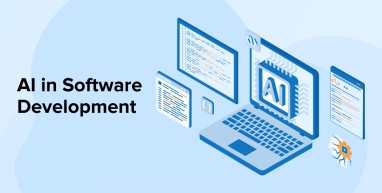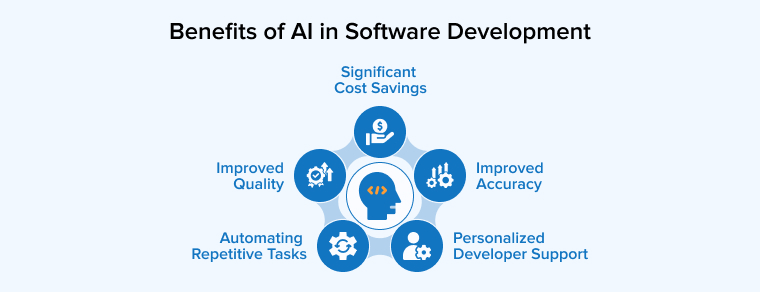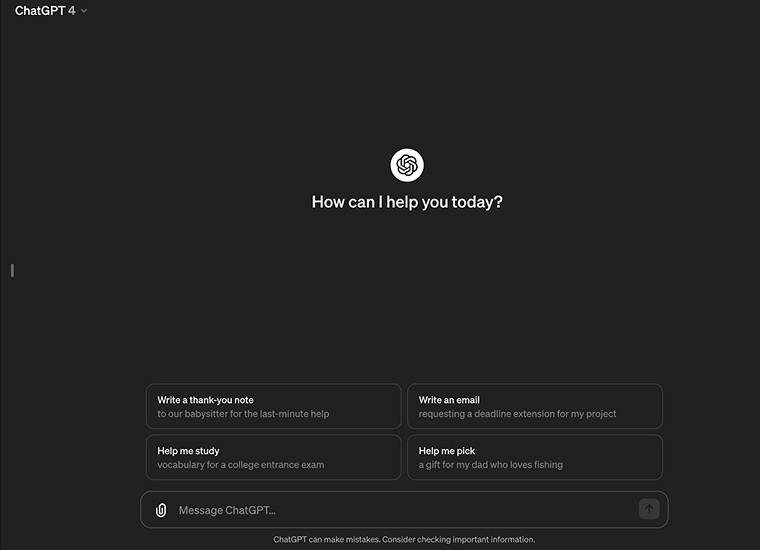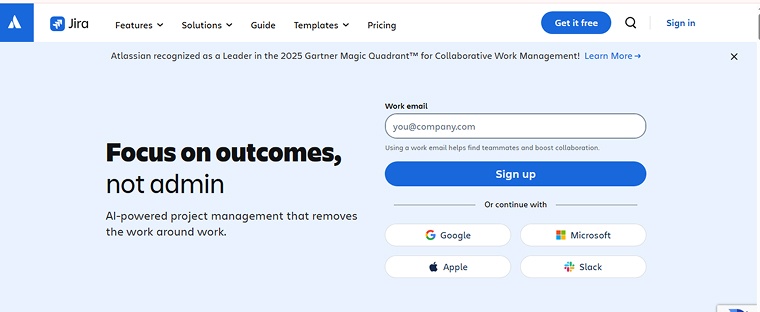
Using AI in software development opens up new opportunities for innovation and helps solve complex problems. Automating various aspects of the software development process speeds things up and reduces costs without compromising quality. If you plan carefully, you can effectively build sophisticated, resilient AI-powered software systems. But building such solutions demands a specific skill set as well. Hiring top AI software development services providers with proven portfolios is the way to go. As per market research, the AI in the software development market size was estimated at USD 674.3 million in 2024 and is projected to reach USD 15,704.8 million by 2033, growing at a CAGR of 42.3% from 2025 to 2033. AI implementation comes with advantages as well as challenges. This article provides an in-depth understanding of the subject and suggests a few popular and robust AI tools to use to reap maximum benefits.
1. What is AI in Software Development?
AI in software development refers to the use of artificial intelligence, machine learning, and natural language processing to design, develop, test, and deploy software quickly and more reliably. It aims towards automating partial or entire processes, including code generation and testing, assisting developers in producing desired outcomes.
Machine learning technology assesses the codebase, identifies patterns and finds bugs before they can cause any harm. Meanwhile, NLP empowers tools to understand plain English commands, allowing them to transform simple instructions into documentation or a fully functional code. Meanwhile, GenAI provides quick suggestions, writes full functions and creates entire modules based on a few lines of prompt.
2. Benefits of AI in Software Development

AI is simplifying software development by automating many of its tasks while ensuring high-quality outcomes. Additionally, using AI in software development helps developers solve complex real-world problems as it delivers a plethora of advantages, such as;
2.1 Improved Quality
Using artificial intelligence helps identify vulnerabilities, bugs, and code inefficiencies early in the software development lifecycle. You can also use AI-powered tools to create and run test cases automatically. AI supports code review and provides predictive analytics for early warnings and problem detection. It can accelerate testing and debugging and help deliver a reliable software system more quickly.
2.2 Automating Repetitive Tasks
Some apps require a lot of boilerplate code, which is not only time-consuming but also overwhelming. Automating this process lets developers focus on writing logic. AI can create boilerplate code that is easily reusable across many places.
On top of that, AI can also automate other development tasks, like code refactoring, software testing, and dependency management. In many instances, headers highlight the dependencies; you can optimize that with a single AI prompt. AI tools can also refactor and reorganize your code, and, as discussed previously, automatically assess it for any errors and vulnerabilities.
2.3 Significant Cost Savings
There are huge cost benefits to implementing AI-driven software development. Automating routine tasks like coding and testing allows developers to focus on more important tasks like creating logic and problem-solving.
As a result, the development cycle speeds up, yielding a shorter time-to-market and earlier revenue generation. Automation also reduces staffing needs, lowering development-team costs. Apart from that, AI improves resource allocation, reducing overspending and waste. AI also streamlines development tasks.
2.4 Personalized Developer Support
Using AI tools provides a personalized experience to developers. These tools offer smart suggestions based on project history and individual coding style. AI enhances developers’ skills and productivity by offering insights, resources, and best practices that align with their interests and requirements. Additionally, integrating AI into the software development process makes it more innovative and efficient, which helps organizations to achieve results quickly and that too with greater accuracy.
2.5 Improved Accuracy
AI-powered software development is less prone to errors compared to manual development and therefore delivers greater accuracy. AI algorithms are designed to find bugs and errors, often detecting issues that human developers overlook. The AI algorithms analyse the code patterns to spot anomalies missed by the developers. As a result, the code quality improves, which reduces the downtime and enhances customer satisfaction. AI is also capable of recognising and enforcing software development best practices to prevent security vulnerabilities and ensure compliance with relevant laws and regulations.
3. How is AI Used in Software Development?
AI technology is driving revolution across many domains, especially software development. Numerous tools and techniques are available that developers can use to enhance individual productivity and improve the efficiency of their processes. You can see the impact of AI across various aspects of the software development process, including:
3.1 AI-powered Code Generation
AI-powered tools such as Amazon CodeWhisperer, GitHub Copilot, and others help developers write code by auto-completing functions and suggesting code snippets. These tools accelerate development and can improve code quality.
AI code generation is one of the most common use cases of AI in software development. Developers can generate full blocks of code using text prompts. Advancements in generative AI have greatly streamlined the code generation process.
GenAI tools support various programming languages and are trained using NLP, large neural networks, and deep learning algorithms, along with a database of existing source codes. Even non-technical personnel can generate code and test cases with GenAI using appropriate prompts.
3.2 Bug Detection and Fixing
Bug detection is time-consuming and often yields incorrect and inaccurate outcomes, leading to unresolved issues and software crashes. Automating the process leads to quicker and more accurate bug detection. AI tools conduct root cause analysis for the errors and perform more tests for similar scenarios.
They use machine learning algorithms to identify patterns and relationships in the data and identify anomalies in the program. The system also uses predictive analysis to identify potential problems. Autonomous and continuous monitoring helps identify and address issues before they can cause major harm.
3.3 Project Management and Documentation
Developers use AI to streamline software development project management. With AI models, they can accurately estimate the time required to complete tasks, schedule them, and allocate appropriate resources efficiently. Automating several aspects of project management allows developers to focus on building solutions.
Moreover, AI tools can generate documentation in your native language, helping team members understand how each code section works and what it does. Manual documentation can be tedious; automating the process with a simple prompt can produce detailed documentation with descriptions for every code snippet.
3.4 Test Automation
You can automate the entire testing process, including generating numerous test cases and analysing code for potential errors and vulnerabilities. Compared with manual testing, automated testing saves time and resources while delivering accurate results more quickly. AI tools learn from past mistakes, improving the testing process each time they run.
They also offer detailed analysis reports, often with visual representations of the problem, and provide suggestions for resolving them. In short, test automation not only improves the efficiency and outcomes of the testing process but also helps deliver high-quality code by offering smart suggestions on how to fix the underlying bugs and issues.
3.5 DevOps and CI/CD Pipelines
Automate monitoring and scaling operations within CI/CD pipelines to enhance build efficiency and deployment speed. AI can manage tasks such as scaling, load balancing, and detecting errors in real time. AI-powered DevOps tools automate the code review process, among other routine tasks.
3.6 UX Design
AI tools provide data-driven insights for building software that delivers an enhanced user experience. AI also applies data on historical interactions and outcomes to suggest design improvements, layout changes, and updates to features, all aimed at offering a personalised experience.
After identifying the user requirements, predictive analysis allows you to adapt to changes and plan future refinements and software development projects. AI also supports user research and testing: for example, it uses heat maps to indicate which workflows need optimisation. In UX design, AI tools offer suggestions to design software, providing accessibility to people with disabilities.
4. Top AI-Powered Software Development Tools
Until now, we have seen what AI tools can do for you in a software development process. Now, it’s time to check out the tools that can actually assist you in delivering effective outcomes. A plethora of options are available in the market, but here we discuss the most popular and reliable AI-powered tools.
4.1 GitHub Copilot

GitHub Copilot is a popular AI editor that writes code, documents, and tests to help automate debugging and deployment. Using this tool in the agent mode provides context-based insights derived from data gathered from different files. Extensions are available to use GitHub Copilot with third-party tools to create feature flags and check logs. You can also install this AI tool easily in JetBrains IDEs and VS Code. Developers around the world use this tool to receive suggestions for full functions, including common patterns.
4.2 Cursor

Built upon Visual Studio Code, Cursor is a widely used AI tool that gives context-aware suggestions and NLP to generate and modify code. You can submit a request in plain language, and Cursor will return executable code.
Cursor provides seamless integration with VS Code extensions. Its features include a chat interface for user interaction and real-time assistance, contextual suggestions to accelerate workflow, predictive code edits, and AI pair programming.
There are various pricing plans depending on usage and features, such as a free hobby plan, a pro plan at $20/month, and a business plan at $40/user/month.
4.3 Figma AI

Figma AI is a creative collaboration tool that helps you bring ideas to life. Enter a single prompt, and it can deliver a working prototype. Even without any coding experience, you can create interactive elements, animations, text effects, and more with code layers from Figma.
The tool is called a collaborator for a reason. It automates repetitive tasks and generates content for design, freeing you to focus on the project’s more creative aspects. With the Dev Mode MCP Server, you can bring the Figma design context directly into coding tools like VS Code, Claude, and Cursor to create a more accurate and efficient design-to-code workflow.
4.4 ChatGPT

ChatGPT provides capabilities for code optimization, debugging, creating code snippets, generating custom test cases, and writing documentation. Its AI-driven recommendations, conversational interface, and natural language processing are particularly helpful to software developers. It speeds up the development process with templates and code snippets. Using ChatGPT can help minimize technical debt. It improves developer productivity and code quality.
A free plan is available for using GPT 3.5, whereas GPT 5.1 has limited free use. There is a pricing plan for $10/month for using GPT 4 with certain restrictions; these limits can be expanded with a team subscription priced at $25 per user per month for an annual plan or $30 per user per month for shorter plans.
4.5 Jira

Jira is a robust project management tool popular among Agile teams for planning, tracking, and managing software development workflows. Atlassian originally created it to detect bugs; it later evolved into a complete suite of services, tailored to the specific requirements of the organisation.
Jira is empowered with GPTZero, which helps check the authenticity of the generated content. It provides boards, epics, workflows, backlogs, and sprints to enable deep customisation. With Jira, you gain total control and visibility across your project ecosystem, even if it is complex.
4.6 Qodo (formerly Codium AI)

Codium AI, now known as Qodo, is designed specifically to integrate with VS Code to enhance the software testing process. As the software developers write code, Codium AI analyses the code, comments, and docstrings to suggest appropriate test ideas. Such real-time assistance prompts developers to consider potential edge cases and helps prevent bugs and errors.
Codium AI’s capabilities extend beyond basic code suggestions. It can also provide insights into how code changes affect the entire software system. Unlike traditional AI assistants, Codium is highly intuitive when used for coding with VS Code. The free version of Codium AI provides test suggestions. However, automated test generation requires a paid plan of $19/month.
5. Key Challenges When Using AI in Software Development

Using AI can streamline the development process, increasing efficiency and productivity while reducing the margin of error. However, there are certain drawbacks as well. To achieve maximum outcomes, you have to address these challenges when using AI in software development.
5.1 Data Privacy and Security Concerns
AI models use a significant amount of data for training purposes, which is often sensitive. Handling that data securely while ensuring compliance with privacy regulations is challenging. These tools are fed data from multiple sources and often have improper data processing, which can raise security and privacy concerns. Therefore, it is recommended to have a proper protocol in place for data processing.
5.2 Data Dependency
AI models require large volumes of data to train them to generate accurate results, recognize patterns, and make predictions. The real challenge lies in gathering such an extensive dataset, which is not easily available or accessible. Moreover, the training data must be highly relevant to the domain the AI model is intended to serve; otherwise, it will be ineffective.
5.3 Bias and Fairness
AI models are trained on data collected from various sources. If biases exist in that data, the models will reproduce those biases. As a result, when a user provides a query related to software development, UX design, or similar topics, the AI algorithms can produce unfair outcomes that perpetuate social inequalities. To address this issue, AI models must be trained on fair, representative, and heterogeneous datasets. Before launch, conduct thorough bias testing. Even after that, implement continuous monitoring and iterative improvement based on model behavior and user interactions.
5.4 Integration with Existing Systems
Legacy systems predominantly rely on outdated technologies, which makes integrating AI difficult and results in siloed data that AI models cannot easily incorporate. Additionally, integrating AI into existing systems can slow down development or cause disruptions in the current workflows, all leading to increased costs.
Seamless AI integration requires careful planning and workflow reengineering. Bridge the gap between new-edge solutions and legacy systems by adopting modern AI tools and methodologies, as well as training the staff to use them.
5.5 Skill Gap
AI in software development demands domain-specific expertise or a specialized skill set, including data science, NLP, and machine learning. You must hire software developers who not only know how to write AI/ML algorithms that solve problems but can also leverage the latest advancements in the field for maximum impact. Although AI is booming, there is a significant shortage of talented AI software engineers in the market.
One reason is that technology has shifted rapidly in recent years. By the time a company or individual completely grasps a development, new changes are already deployed. So, you might be on the lookout for developers skilled in the latest or trending technologies, but it takes time for humans to understand and master them.
6. Conclusion
Implementing AI in software development can streamline the process and increase its efficiency. Other benefits include faster time to market, reduced costs, fewer errors, and higher-quality outcomes. Developers can use AI tools such as Figma, ChatGPT, and GitHub Copilot to automate various aspects of the software development process, including UX design, code generation, testing, debugging, documentation, and project management. Although teams may face challenges, adhering to the best practices ensures desired results.




Comments
Leave a message...